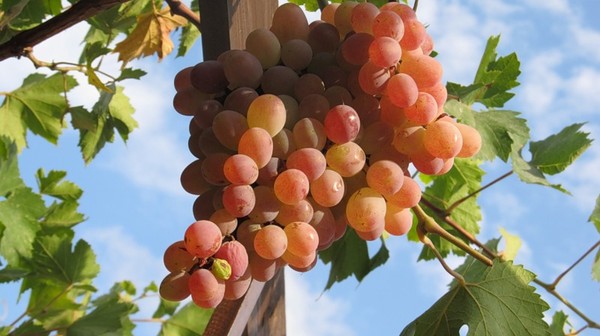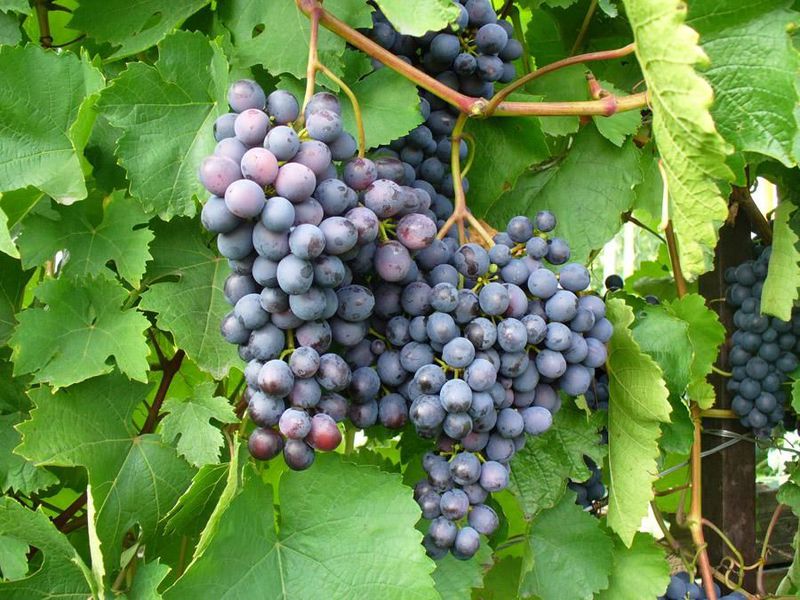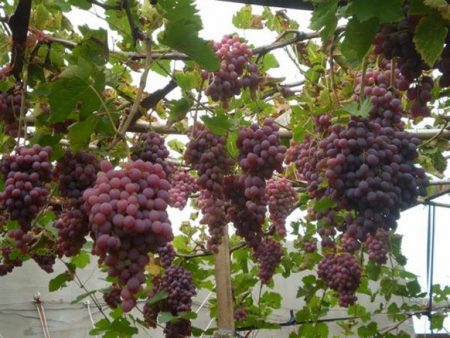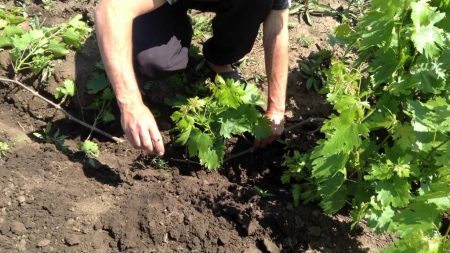
The variety is ancient, the first plantations of pink typhi appeared in Samarkand, Bukhara in the 7th century AD. Frost resistance of grapes is weak, therefore, the Asian variety is grown only in regions with mild, warm winters.
For the versatility of the fruits, their original taste, the table variety is popular among professional winegrowers.
Content
general description

Tayfi pink is included in the group of oriental (Asian) grape varieties. The growing season is long - more than 160 days. The more warm days in the summer, the more the accumulation of sugars takes place. Weak winter hardiness of the bushes does not allow to grow the variety in conditions with low heat supply.
Bush characteristics
Typhi grapes are a tall plant. In young shoots, maturity is not lower than 80%, they have:
- slightly colored crowns;
- border of raspberry color;
- cobwebly pubescence;
- the color of the axis is wine red;
- slightly dissected leaves, lobes bent up.
The leaves on the fruiting shoots are large, five-lobed, deeply dissected. The upper surface of the leaf plates is uneven (wavy), its edges are slightly bent. The bottom is smooth or with a slight pubescence on the veins.
Taifi pink's conical or conical-cylindrical clusters are large (600 g) and very large. In length, they can reach up to 27 cm, in width up to 19 cm. In structure, they are loose, have strongly developed lateral lobes, a leg from 3 to 7 cm long.
The size of the berries is large, the shape is oval, oval-cylindrical, length about 27 mm, diameter 19 mm. The peel of the ripened berry is dark pink with a pronounced shade of purple. A wax coating is visible on the surface, dots are noticeable.

Grapes Agat Donskoy: characteristics and description of the variety
Beginning winegrowers can grow Agate Donskoy grapes. The Russian variety is well adapted to any ...
The skin of berries is thick, bright red inside. The crisp pulp has a pleasant taste, dense structure. The size of the seeds is average, the amount is from 2 to 3. The juice of the berry is colorless, its composition:
- sugars in 100 ml - 17.2 g;
- acids 6.5 g / l.
Taste and its tasting assessment depend on the region of cultivation. Tayfi pink, grown in Central Asia, has 9 points, in other regions below - 7.4. During transportation, the berries do not crumple, they are stored in the refrigerator until spring (March). During storage, shedding of the fruits, wilting of the ridges is observed.
Typhi pink is classified as table variety, berries are used fresh, used in winemaking, juice is prepared from them, and raisins are dried. The taste of wine is tart. In industrial cultivation, Typhi shows a yield of 20 t / ha.
Advantages and disadvantages

At varieties There are many advantages, but there are also disadvantages. You need to evaluate them before purchasing seedlings.
| Advantages | disadvantages |
| high percentage of shoot maturation | subject to oidium, mildew |
| no pollinators needed | affected by a spider mite |
| drought tolerance | low frost resistance |
| long-term storage of the crop |
|
| berries do not crumble | |
| fruiting in stepsons | |
| transportability | |
| universal purpose of fruits | |
| great taste |
Landing
Propagate Typhi cuttings. They take root well. Planting seedlings is on the south side of the house. Bushes grow powerful, this must be taken into account when planting, withstand an interval of 3 meters.
The variety is not picky about the composition of the soil.In addition to garden soil, it is worth adding to the landing pit:
- ash 1 liter jar;
- humus 1 bucket;
- sand 0.5 buckets.
The size of the pit is small: depth 0.5 m, diameter 0.6 m. Drainage to the bottom and support are needed. The main requirements for the landing site: 100% illumination during the day, protection from the north wind, deep occurrence of groundwater.
Care Features

The grapes tolerate drought, but with regular watering the yield is higher. To keep the soil moist, they use organic mulch, re-heating, it, in addition to protective functions, acts as an organic fertilizer.
Features of agricultural technology:
- form like a standard culture;
- leave a large number of perennial shoots;
- cut to 7-9 eyes;
- the crop is normalized, leaving 5 to 6 eyes on the shoot.
Typhy bears fruit in stepsons, this must be taken into account. For better sugar accumulation, the clusters are left on the bushes.
Diseases and Pests
Weak resistance to fungal infections complicates the care of Typhi. The vine is subject to mildew and oidium. From the latter, you can lose the whole crop. For the prevention of oidium, agrotechnical methods are used:
- pinching stepchildren;
- garter of young shoots;
- weed removal.
These measures improve the ventilation of the bushes. In addition, bushes are treated with Topaz, Horus, and Strobi preparations. The same remedies are effective against mildew. This disease provokes wet weather.
In addition to 3 treatments with fungicides: during periods of shoot growth, before flowering, when the fruits are formed, the bushes are fed with phosphorus-potassium fertilizers, mulch the soil to normalize moisture.
Of the pests, you should be wary of the spider mite. For prevention in the fall, the earth under the bushes is dug up, all plant residues are removed. Apply chemical agents from the parasite:
- Karbofos;
- Fitoverm;
- Actellik.
Reviews
Andrey, Rostov Region
Pink Typhi is the most beloved grape variety. From year to year, it pleases with wonderful crops. It tastes good, clusters are large, beautiful. The color intensity varies over the years. Sugar berries gain more if removed later. They do not crease and do not rot, their shape is oval, the bunch is loose.
Sergey, Kazakhstan
We have typhi pink is very popular. Many growers grow it. My berries are rounded, clusters conical, expanded at the top. Lateral branches are well developed. The taste depends on the place of cultivation, astringency may be present. The flesh is crispy.
Alexey, Rostov Region
The bush is a three-year-old planted with a shank. The first unpainted signaling took off last summer. Today, the first berries began to be eaten after August 20, and by the beginning of September sugar had gained well. The pulp with a crunch, dense.
Victor, Kazakhstan
My bushes are over 40 years old. There are two of them, growing in the yard on a pergola. I’ll cover them for the winter. Bunches hang to frost, the berry does not crack. I keep the harvest in the basement, it can lie until spring, but we eat everything earlier. I tried to make wine out of it, I liked the result.
The variety requires a lot of experience from the grower; not everyone can grow it. Typhi is a heat-loving variety, so in moderate climates it is difficult to get high yields.

 Non-covering winter-hardy grape varieties for Moscow region
Non-covering winter-hardy grape varieties for Moscow region How to keep the vine in winter
How to keep the vine in winter When can I transfer grapes to another place in the fall
When can I transfer grapes to another place in the fall How to cover and prepare grapes for the winter in the suburbs
How to cover and prepare grapes for the winter in the suburbs